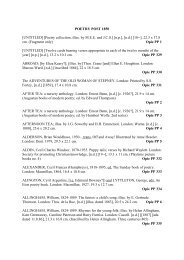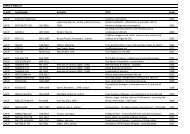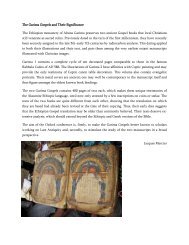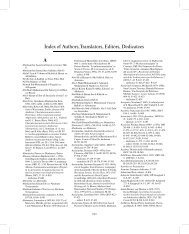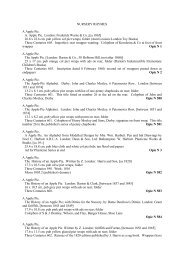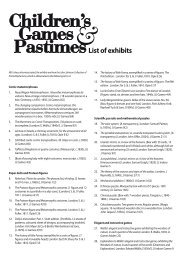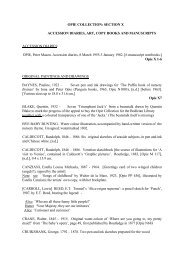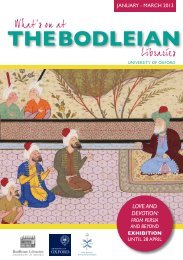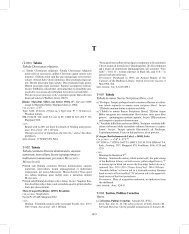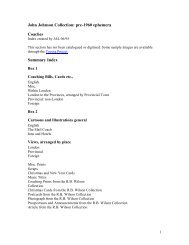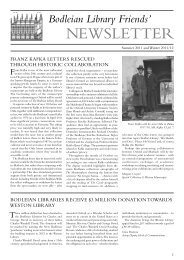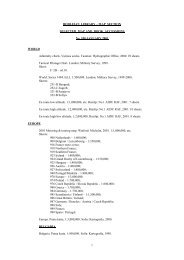Julie Anne Lambert Children's games & pastimes - Bodleian ...
Julie Anne Lambert Children's games & pastimes - Bodleian ...
Julie Anne Lambert Children's games & pastimes - Bodleian ...
Create successful ePaper yourself
Turn your PDF publications into a flip-book with our unique Google optimized e-Paper software.
<strong>Julie</strong> <strong>Anne</strong> <strong>Lambert</strong><br />
Children’s <strong>games</strong> & <strong>pastimes</strong><br />
The John Johnson Collection is well-known to readers<br />
of The Ephemerist, but the current <strong>Bodleian</strong> exhibition<br />
focuses on two of its perhaps less familiar areas:<br />
children’s <strong>games</strong> and engraved writing blanks (or<br />
school pieces). Since the well-publicised acquisition of<br />
the Opie Collection in 1988, the <strong>Bodleian</strong> has become<br />
a focus for research into children’s literature and<br />
the <strong>games</strong> in the John Johnson Collection have been<br />
increasingly in demand. Children’s <strong>games</strong> & <strong>pastimes</strong><br />
is an exhibition, principally from the John Johnson<br />
Collection, in the Exhibition Room of the <strong>Bodleian</strong><br />
Library, University of Oxford.<br />
The exhibits are drawn mainly from the following<br />
sections of the Collection: Games folder (singlesheet<br />
board <strong>games</strong>), Games artefacts (three-dimensional<br />
<strong>games</strong>), Miniature theatre, Educational folder 5<br />
(engraved writing blanks), Indoor <strong>games</strong>, Alphabets,<br />
Battledores, and Exercise books. They are supplemented<br />
by books from the Opie Collection and the Library’s<br />
general holdings, and by school pieces from the<br />
Harding and Opie collections. A miniature theatre is on<br />
loan from a private collection.<br />
Games are fascinating for the insights they give into<br />
the social mores and assumptions of their age and also<br />
for the ingenious ways in which publishers sought to<br />
sweeten the educational pill with novelties and invention.<br />
The exhibition was inspired by (and is supported<br />
by) recent digitisation of board <strong>games</strong>, selected threedimensional<br />
<strong>games</strong>, and the entire <strong>Bodleian</strong> collection<br />
of school pieces. This Oxford Digital Library project<br />
(funded by the Andrew W. Mellon Foundation) will<br />
soon be available online through the ODL site, together<br />
with other similar Oxford University Libraries projects,<br />
including eighteenth-century Entertainment from the<br />
John Johnson Collection. Both John Johnson Collection<br />
projects are already available through the online<br />
catalogue (www.bodley.ox.ac.uk/johnson/), together<br />
with thousands of images from other sections of the<br />
Collection.<br />
The exhibition consists of 136 items (supplemented<br />
by a further 32 in the temporary Christmas case), highlights<br />
of which are discussed below. They are divided<br />
into 11 themes.<br />
In Comic Metamorphoses we exhibit several dissected<br />
pictures which can be variously arranged with<br />
comic effect. Although usually showing humans in<br />
national or fancy dress, and animals, the Neue Wagen-<br />
12<br />
Metamorphosen uses images of different types of transport.<br />
Other forms of metamorphosis include the superimposition<br />
of a variety of costumes on a figure or head<br />
(frequently androgynous).<br />
The John Johnson Collection has a small collection<br />
of Paper Dolls and Protean Figures, ranging in date<br />
from 1811 to the 1890s. The male figure in The Protean<br />
figure and Metamorphic costumes (1811) was presented<br />
in a slip-case with a wide range of costumes. Reiterlust<br />
(c.1860s) is a box containing men in national military<br />
costumes with horses, on which they were to be<br />
mounted. Female dress is represented by Lucile Grahn.<br />
Erste Tänzerin von London (c.1840), a real dancer, and by<br />
Lady Margaret, who is representative of an upper-class<br />
lady of the 1890s. From the Opie Collection, there is a<br />
chance to see three copies (in different editions) of The<br />
history of little Fanny, exemplified in a series of figures<br />
(1810) in which Fanny’s head was to be moved from<br />
costume to costume as the story progressed.<br />
Three high-quality <strong>games</strong> published by Samuel Leigh<br />
in 1824-25 are shown: two myrioramas (discussed<br />
later) and (in the case entitled Scientific Pursuits and<br />
Mathematical Puzzles) an astronomical aid: Urania’s<br />
mirror; or, A view of the heavens, on a plan perfectly<br />
original. Designed by a Lady. This fine box of 32 cards<br />
was accompanied by a specially written book: A familiar<br />
treatise on astronomy (not exhibited), by Jehosaphat<br />
Aspin. The cards are perforated with the shapes of<br />
the constellations, ‘so as to exhibit, when held up to<br />
the light, their natural appearance in the Heaven’. The<br />
Examiner, in its review of Urania’s Mirror, states that:<br />
‘nothing perhaps is more characteristic of the present<br />
age than these helps to the acquirement of knowledge’.<br />
Whereas the cards in Urania’s Mirror are backed with<br />
white tissue paper, the other two hold-to-light astronomical<br />
aids in the case (The portable Eidouranion;<br />
or, Juvenile transparent solar system published by<br />
John Offer and The solar system published by Samuel<br />
Palmer) have coloured tissue attached to the verso.<br />
Georgian and early Victorian board <strong>games</strong> (shown<br />
in Elegant and Instructive Games) were invaluable<br />
instructional aids, in areas such as geography, history,<br />
and morality. Many were race <strong>games</strong>, played with a<br />
spinner and teetotum rather than dice, which were<br />
associated with gambling. They were accompanied by<br />
books of rules which included lengthy explanations of<br />
the historical period or geographical area represented<br />
in the game. Often such commentaries did not limit<br />
themselves to the purely factual. In Bowles’s British<br />
geographical amusement, 1780, the publisher indulges<br />
in glosses such as: ‘Cambridge, a disagreeable town’,<br />
‘Oxford, a pleasant city’ or ‘Hertford, large and dull.’
Later <strong>games</strong> tend to be less didactic, while still teaching<br />
children skills. Most fall into the categories of race<br />
game or siege game, the latter being popular with boys.<br />
We show three siege <strong>games</strong>: Siege of Sebastopol (board<br />
only), Siege of Paris and two copies of Belagerungs-<br />
Spiel. Le jeu de siège. The play of siege, which incorporates<br />
a board for Nine Men’s Morris in its lid and a<br />
draughts board on its base.<br />
The Toy Theatre section focuses on the work of<br />
Benjamin Pollock, with characters, scenes, and tricks<br />
from The Battle of Waterloo, Forty thieves, Oliver Twist,<br />
and Whittington and his cat or Harlequin Lord Mayor of<br />
London. The ‘Neptune’ toy theatre (kindly lent by Peter<br />
Baldwin) is set up with scenes and characters from The<br />
Corsican Brothers.<br />
We show several kinds of Jigsaws and Dissected<br />
Puzzles, including Whole length portraits of the Kings<br />
and Queens of England, displayed in chronological<br />
order, exhibiting the age, death, and character, of each<br />
monarch, with the principal events of their reign, John<br />
Passmore (c.1847), in which the facts are supplemented<br />
by comments, often caustic, on the monarchs (among<br />
whom is Oliver Cromwell!): ‘Edward 4 ... profligate and<br />
cruel’, ‘James I ... learned but weak’. Roarem Castle is an<br />
interesting example of the re-use of lithographic stones.<br />
We have it as both a game and a jigsaw game (complete<br />
with tokens, rules, teetotum, etc.) The Standring<br />
imprint is omitted from the jigsaw, which was presumably<br />
produced by puzzle specialists. Also shown are<br />
block puzzles and a double-sided puzzle.<br />
Alphabets are Fun enables us to exhibit many forms<br />
of alphabet: panoramic, battledores (including a luxurious,<br />
hand-coloured example by William Darton junr.),<br />
sheets, cards, discs, dominoes, a volvelle, and books. The<br />
earliest, a hornbook of c.1620, is the oldest known of its<br />
kind.<br />
The choice of words to associate with the letters is<br />
fascinating, reflecting both the preoccupations and novelties<br />
of the age. Many mid nineteenth-century alphabets<br />
shown feature exotic animals and birds, for example:<br />
avocet, emu, elk, ibis, ibex, nyl-ghau, zebus, zebu,<br />
and zorilla, complicated words perhaps unexpected in<br />
otherwise fairly rudimentary alphabets but reflecting<br />
the fashion for showing animals imported from foreign<br />
lands, as curiosities.<br />
The most difficult letter was X, often ignored, or represented<br />
by Xerxes or X for ten. The Darton Battledore.<br />
A present from London (1829) states that X begins no<br />
English word. The later Father Christmas ABC (1894)<br />
solves the problem with Xmas tree!<br />
Modelling in paper and cardboard through to mosaics<br />
and building blocks forms the basis of The Little<br />
Builder, while more verbal <strong>games</strong> are shown in Parlour<br />
Games. In this case we show books with such enticing<br />
titles as: The gaping, wide-mouthed, waddling frog. A<br />
new and entertaining game of questions and demands.<br />
With proper directions for playing the game and crying<br />
the forfeits (which represents the fashion for remembering<br />
ever longer pieces of text) and The frisking, barking,<br />
lady’s lap-dog. A new game of questions and commands.<br />
Also shown are some parlour scientific experiments.<br />
Brush, Pen, and Pencil is the showcase for a selection<br />
of the school pieces and also for the myrioramas<br />
and variants in the John Johnson and Opie Collections,<br />
as well as for books on drawing and watercolour. There<br />
are also examples of children’s work in exercise books,<br />
and an array of artefacts, including quills, an ink pot,<br />
paint boxes, and drawing slates.<br />
Two of the many myrioramas shown were published<br />
by Samuel Leigh and designed by John Clark:<br />
Myrioramas; or, many thousand views and Myriorama.<br />
Second series. Italian scenery (both from the Opie<br />
Collection). These consist of 16 and 24 cards respectively,<br />
which could be placed in any order to form<br />
different landscapes, the horizons all matching. The<br />
chosen scenes were to be copied. 16 cards formed<br />
an astonishing 20,922,789,888,000 variations. The<br />
Choriorama, published by J. Burgis in c.1825, is complete<br />
with its instructions. These give the strip numbers<br />
needed to make up Byland Abbey, Hastings Castle,<br />
Southampton, Tintern Abbey, and Sandford Castle<br />
and Isle of Portland, and then proceed to a discussion<br />
of composition, mixing colours, shading, and clouds,<br />
with colour samples in watercolour throughout. We<br />
also show a Milliorama (a French example in a smaller<br />
format) and a Polyorama published by Hodgson & Co.<br />
For an explanation of the French origins and of the variants<br />
of myrioramas, see Ralph Hyde’s excellent article:<br />
Myrioramas, endless landscapes The story of a craze in<br />
Print Quarterly vol. XXI, number 4, December 2004.<br />
One of the strengths of the John Johnson Collection<br />
is its collection of 66 engraved writing blanks (called<br />
school pieces, schoolboys’ pieces, or Christmas pieces)<br />
by a wide variety of publishers. These are supplemented<br />
by 45 in the Harding Collection, consisting<br />
predominantly of school pieces by W. Belch, mostly on<br />
religious themes. There are also two exquisite writing<br />
blanks in the Opie Collection: Harlequin and Mother<br />
Goose and Infantile Sports, both published by Laurie &<br />
Whittle in the early years of the nineteenth century.<br />
School pieces were folio sheets with printed borders<br />
(usually engraved) and a blank centre, given to children<br />
from c.1720 to1860, usually at Christmas, to fill in to<br />
show how their handwriting had improved during the<br />
13
McCaw<br />
17
year. In The progress of education, one of the vignettes,<br />
‘Shewing his friends his schoolpiece’, shows the presentation<br />
of such a writing sheet.<br />
Of the 113 writing blanks or school pieces in the<br />
<strong>Bodleian</strong> Library, only 21 have been written on. They<br />
had standard themes, such as: religion; military and<br />
naval; royal and ceremonial; tales; rural life, and historical<br />
events.<br />
In Outdoor Games we show many illustrations and<br />
plates from books: ‘the battledoor’, ‘hare and hounds’,<br />
and ‘the devil on two sticks’. Weibliche Gÿmnastik<br />
(female gymnastics) includes a sheet of exercises for<br />
figured dance in addition to complex instructions for<br />
gymnastic activities, depicted on numbered blocks.<br />
The Christmas case, A Christmas Box (until<br />
December 22 only), is divided between Christmas cards<br />
and scraps showing children playing <strong>games</strong> and pantomimes<br />
(books of words). Five beautiful pantomime<br />
posters are displayed throughout the run of the exhibition.<br />
There is no exhibition catalogue but a 9-page folded,<br />
illustrated colour guide to the exhibition can be purchased<br />
at the exhibition at £1.00. It can also be obtained<br />
by mail order at £3.00 (UK mainland), £4.00 (worldwide),<br />
both inclusive of postage and packing. Cheques<br />
(UK only) payable to <strong>Bodleian</strong> Library, or credit card.<br />
No cash.<strong>Bodleian</strong> Library Sales, <strong>Bodleian</strong> Library, Broad<br />
Street, Oxford, OX1 3BG. Tel: +44 (0)1865 277091 A<br />
list of exhibits is available in the Exhibition Room only,<br />
free of charge.<br />
<strong>Julie</strong> <strong>Anne</strong> <strong>Lambert</strong> is the Librarian of the John<br />
Johnson Collection<br />
19



